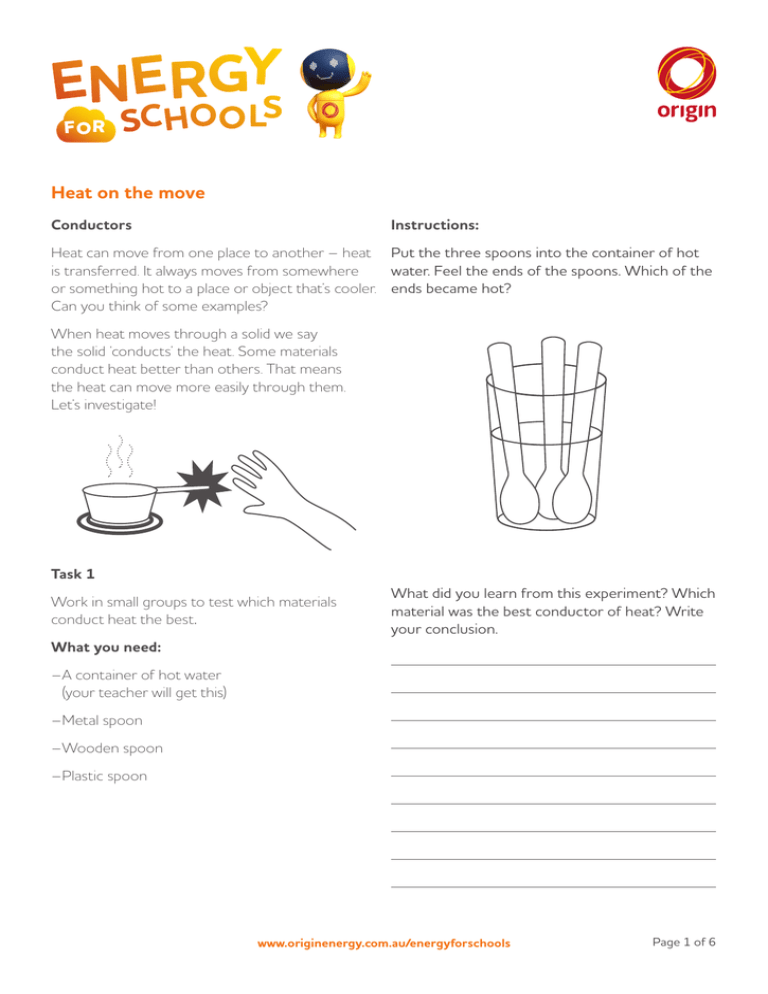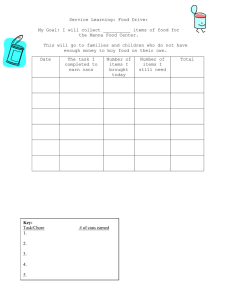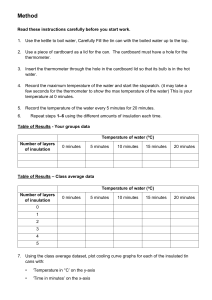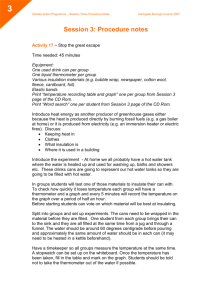Heat on the move
advertisement

Heat on the move Conductors Instructions: Heat can move from one place to another – heat Put the three spoons into the container of hot is transferred. It always moves from somewhere water. Feel the ends of the spoons. Which of the or something hot to a place or object that’s cooler. ends became hot? Can you think of some examples? When heat moves through a solid we say the solid ‘conducts’ the heat. Some materials conduct heat better than others. That means the heat can move more easily through them. Let’s investigate! Task 1 Work in small groups to test which materials conduct heat the best. What did you learn from this experiment? Which material was the best conductor of heat? Write your conclusion. What you need: –A – container of hot water (your teacher will get this) –Metal – spoon –Wooden – spoon –Plastic – spoon www.originenergy.com.au/energyforschools Page 1 of 6 Heat on the move Insulators Instructions: Just as some materials are good conductors of heat, such as metals, others are good insulators. An insulator prevents or reduces the movement (or transfer) of heat. Many houses have insulation in the ceiling to stop heat entering in the summer and escaping in the winter. What kind of insulation do many cold-climate animals use? Did you think of fur? Step 1: Wrap different material around each of three cans. Decide which will be ‘Material 1’, which one ‘Material 2’ and which ‘Material 3’. Leave one can without any insulation. Task 2: Work in small groups to investigate which materials are good insulators. You will investigate how to slow down the transfer of heat through the sides of an aluminium can. Remember to be very careful when you experiment with heat. What you need: Why is it a good idea to leave one can without any insulation? –Thermometer – –Four – aluminium drink cans the same size –Thick – cardboard: a large piece to place cans on; four square pieces for ‘lids’ –Hot – water (your teacher will provide water at about 50°C) –Watch – or clock –Measuring – jug Step 2: Before pouring in the hot water, place the cans where they are going to stay for 60 minutes. All the cans should be placed in the same conditions. It is best if they are put on a layer of cardboard and not placed in direct sunlight. –Three – different types of material (for example cotton wool, styrofoam, bubble wrap) www.originenergy.com.au/energyforschools Page 2 of 6 Heat on the move Why is it best not to pick up the unwrapped can once it has hot water in it? HINT: Think about your earlier investigation that showed metal is a good conductor of heat. Step 3: Use a measuring jug to fill each can with the same amount of hot water. A typical drink can holds 375 ml of water. Put a thick cardboard lid on top of each can to stop heat escaping from the top. Why is it important that all the cans are kept in the same conditions? (Think about how the results might be affected if you left one of the cans without a cover on top.) www.originenergy.com.au/energyforschools Page 3 of 6 Heat on the move We use a thermometer to measure temperature – how hot something is. The units we use in Australia are degrees Celsius (°C). For example, water freezes at 0°C and boils at 100°C. Step 4: Measure the initial (starting) temperature of the water in each can and record it in the table. Whenever you are not measuring the temperature leave the cover on the can. Step 5: Make a prediction about the temperature of the water after 60 minutes. I predict that the water in the can with no insulation / material 1 / material 2 / material 3 will be the coolest. (Circle one) I predict that the water in the can with no insulation / material 1 / material 2 / material 3 will be the warmest. (Circle one) What are the reasons for your predictions? www.originenergy.com.au/energyforschools Page 4 of 6 Heat on the move Step 6: Record the temperature of the water in each can every 15 minutes. Make sure to measure the water at the same depth each time. Enter the temperatures in the table. Can Starting temperature (°Celsius) 15 minutes Name: Record the results of the experiment in the table below. 30 minutes 45 minutes 60 minutes Plain can Material 1 Material 2 Material 3 www.originenergy.com.au/energyforschools Page 5 of 6 Heat on the move Step 7: Answer the questions below. 1. C alculate the temperature difference of the water in each can after 1 hour. (Take away the final temperature from the initial temperature.) –Was – each of the materials covering the same area of the can? Plain Material 1 Material 2 Material 3 5. W hat did you learn from this experiment? Write your conclusion. 2. Which can lost the most heat? Which can retained (kept) the most heat? 3. How do these results compare with your predictions? 6. T hink of another experiment you could do to explore insulation and the transfer of heat. Extra challenge 4. Could anything besides the insulation have affected the results? Draw a column graph of your results over time for the can with the lowest and can with the highest temperature. –Were – the cans left in the same conditions? –How – accurate were your measurements – was the thermometer placed at the same depth in each can? www.originenergy.com.au/energyforschools Page 6 of 6


